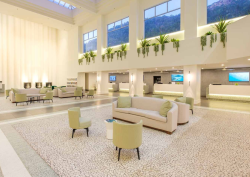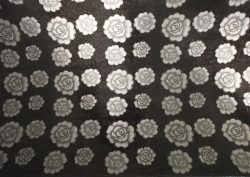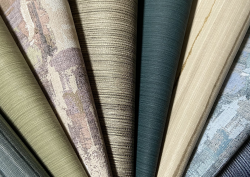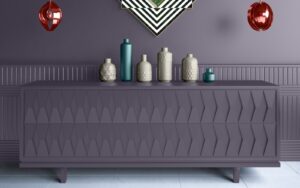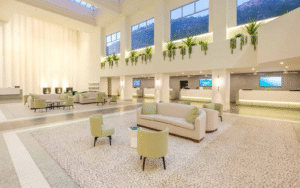Architextural delves into the fascinating world of architectural films, to uncover the creative possibilities they unlock and why they represent a path to a more sustainable, imaginative future for the hotel industry…

Architectural films, also known as surface films, are not your typical design materials. At first glance, the uninitiated may wonder: What can these films achieve? The answer according to the Architextural team, lies in their adaptability and creative potential.
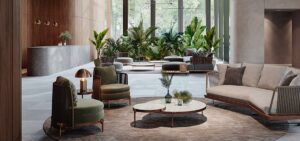
Image credit: Architextural
The spectrum of finishes available in architectural films is vast and varied, catering to an array of design aesthetics.
These include, but are not limited to: Wood Grains: From classic oak to exotic teak, wood grain films bring warmth and elegance to spaces. In a hotel, these can be used in guest room furnishings, creating a cosy, homely feel, or in communal areas like lounges and bars for a sophisticated touch.
Metallics: Metallic finishes offer a sleek, modern look. They can be used in hotel lobbies for a contemporary, upscale ambiance or in lifts to maintain a modern aesthetic throughout the building.
Marble and Stone: These films replicate the luxury of natural stone and marble without the associated cost and maintenance. They are ideal for spa areas, where they can create a serene, opulent environment, or in bathrooms for a touch of elegance.
Abstract and Artistic Designs: Offering a range of designs from subtle textures to bold patterns, these films can be used to add visual interest to spaces like conference rooms or hotel corridors, making them more engaging.
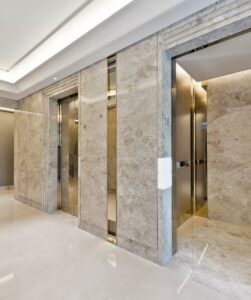
Image credit: Architextural
Decorative window films elevate the aesthetic and functional aspects of hotel design, skilfully balancing light control and privacy with stunning visual appeal. In guest rooms, they provide a soothing ambiance, gently diffusing daylight while ensuring seclusion. In dining areas, their subtle light filtration creates an inviting, intimate atmosphere, crucial for a memorable guest experience. Beyond mere functionality, decorative window films serve as an artistic statement, harmonising with the hotel’s interior theme, whether it’s the understated elegance of minimalism or the rich vibrancy of a more elaborate decor. Their versatility in design and application positions them as an indispensable element in the narrative of modern hotel design, enhancing both the beauty and the comfort of the spaces they adorn.
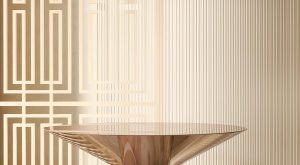
Image credit: Architextural
Cost-Efficiency and Timeliness: Architectural films represent a cost-effective solution for hotel renovations. A mid-sized hotel undergoing refurbishment can significantly reduce expenses by opting for these films instead of traditional materials. The installation process is quicker and less invasive, meaning renovated areas can reopen sooner, thus minimising disruption to guests and operations.
Minimal Maintenance: In high-traffic areas like hotel lobbies, architectural films that mimic high-end materials prove advantageous. They are easy to clean and maintain, keeping spaces looking immaculate with minimal effort. This is especially beneficial in areas that see a lot of guest activity.
Enhancing Brand Identity: Architectural films can play a significant role in reinforcing a hotel’s brand identity. By enabling design consistency across different spaces, from lobbies to rooms to recreational areas, they help create a distinct and recognisable brand image. This consistent visual language speaks volumes about the hotel’s attention to detail and commitment to providing a unique guest experience.
Versatility in Rebranding and Redesigning: For hotels looking to rebrand or update their look, architectural films offer an efficient solution. They allow for a complete overhaul of the interiors without the need for extensive construction work. This versatility makes it easier for hotels to stay current with design trends and guest preferences.
Safety and Compliance: Architectural films can also contribute to the safety and compliance aspects of hotel design. Certain films come with fire-retardant properties or enhanced durability, ensuring that aesthetic enhancements do not compromise safety standards.
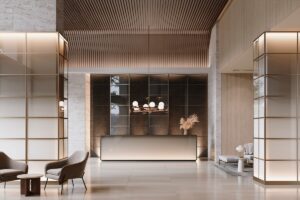
Image credit: Architextural
These innovative materials are not just about aesthetic enhancement; they also represent a significant stride in environmentally conscious design. Architectural films offer a sustainable alternative to traditional building materials, reducing the environmental footprint of hotel renovations and new constructions.
Reduced Resource Consumption: One of the primary advantages of architectural films is their ability to mimic natural and synthetic finishes without the heavy resource consumption associated with manufacturing and transporting traditional materials. For instance, a film that replicates the look of wood or marble eliminates the need for actual timber or stone, thereby conserving natural resources and reducing deforestation and quarrying impacts.
Energy Efficiency: Architectural films can contribute to the energy efficiency of hotels. Certain window films are designed to provide improved thermal insulation, reducing the need for excessive use of heating or cooling systems. This not only aligns with sustainability goals but also translates into lower energy costs, making it a win-win for the environment and your budget.
Longevity and Waste Reduction: The durability of architectural films also plays a crucial role in their sustainability. Their resistance to wear and tear means that they don’t need to be replaced as frequently as some traditional materials, leading to a reduction in waste. Additionally, many architectural film options are recyclable, further minimising their environmental impact at the end of their lifecycle.
Low VOC Emissions: Unlike some conventional building materials and finishes, architectural films often have low volatile organic compound (VOC) emissions. This is significant from an environmental health perspective, as VOCs contribute to air pollution and can have adverse health effects on both guests and staff.
The use of architectural films in hotel design is a multifaceted approach that combines aesthetics, functionality, cost-effectiveness and environmental responsibility. These films offer a practical yet innovative solution for hoteliers and designers seeking to make a lasting impression on guests while being mindful of operational efficiency and sustainability. As the hospitality industry continues to evolve, architectural films stand out as a key element in creating spaces that are not just visually appealing but also aligned with the broader goals and values of the industry.
Architextural is one of our Recommended Suppliers and regularly features in our Supplier News section of the website. If you are interested in becoming one of our Recommended Suppliers, please email Katy Phillips.
Main image credit: Architextural





